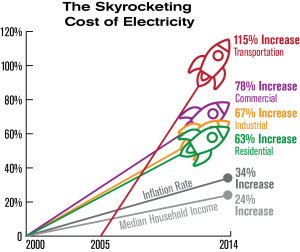Irregularity

A central issue in power spot value demonstrating and guaging is the proper treatment of irregularity. The power cost displays irregularity at three levels: every day and week by week, and somewhat – yearly. In transient determining, the yearly or long haul irregularity is normally disregarded, however the day-to-day and week-by-week designs (counting a different treatment of occasions) are of prime significance. This, nonetheless, may not be the right methodology. As Nowotarski and Weron have as of late shown, deteriorating a progression of Fort Worth Electricity Plans into a drawn out occasional and a stochastic part, demonstrating them freely and joining their conjectures can bring – as opposed to a typical conviction – an exactness gain contrasted with a methodology where a given model is aligned to the actual costs.
In mid-term anticipating, the day-to-day designs become less pertinent and most EPF models work with normal day-to-day costs. Nonetheless, the drawn-out pattern cycle part assumes a vital part. Its misspecification can present a predisposition, which might prompt a terrible gauge of the mean inversion level or of the cost spike force and seriousness, and thusly, to underrating the gamble. At last, in the long haul, when the time skyline is estimated in years, the day-to-day, week by week, and, surprisingly, yearly irregularity might be overlooked, and long haul patterns rule. Sufficient treatment – both in-example and out-of-test – of irregularity has not been actually focused on sufficient consideration in the writing up to this point.
Variable choice
One more vital issue in power cost estimating is the fitting decision of logical factors. Aside from verifiable power costs, the flow spot cost is reliant upon an enormous arrangement of basic drivers, including framework loads, climate factors, fuel costs, the save edge (i.e., accessible age short/over-anticipated request), and data about planned upkeep and constrained blackouts. Albeit “unadulterated cost” models are some of the time utilized for EPF, in the most well-known day-ahead determining situation most creators select a blend of these major drivers, in light of the heuristics and experience of the forecaster. seldom has a mechanized choice or shrinkage method been completed in EPF, particularly for a huge arrangement of starting illustrative factors
Probabilistic gauges
The utilization of expectation spans (PI) and densities, or probabilistic estimating, has become substantially more typical throughout the course of recent many years, as specialists have come to comprehend the limits of point conjectures. In spite of the strong move by the coordinators of the Worldwide Energy Determining Contest 2014 to require the members to submit figures of the 99 percentiles of the prescient conveyance (day-ahead in the cost track) and not the point conjectures as in the 2012 version, this doesn’t appear to be a typical case in EPF at this point. Assuming PIs are registered by any means, they for the most part are dissemination based (and approximated by the standard deviation of the model residuals) or experimental. Another figure mix (see underneath) method has been presented as of late with regard to EPF. Quantile Relapse Averaging (QRA) includes applying quantile relapse to the point estimates of a few individual guaging models or specialists, consequently permitting to use of existing improvement of point anticipating.
Consolidating gauges
- Agreement figures, otherwise called joining conjectures, estimate averaging, model averaging and council machines, outfit averaging, or master total (in AI), are expectations representing things to come that are made by consolidating a few separate gauges which have frequently been made utilizing various philosophies.
- In spite of their ubiquity in econometrics, found the middle value of conjectures has not been utilized widely in that frame of mind of power markets to date. There is some restricted proof on the ampleness of joining estimates of power interest, yet it was, truth be told, as of late that consolidating was utilized in EPF and just for point figures.
- Joining probabilistic (i.e., stretch and thickness) conjectures is significantly less famous, even in econometrics as a general rule, essentially in light of the expanded intricacy of the issue. Since Quantile Relapse Averaging (QRA) permits to use of existing improvement of point estimating, it is especially appealing according to a functional perspective and may turn into a well-known device in EPF sooner rather than later.

